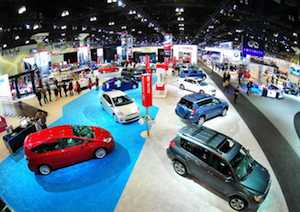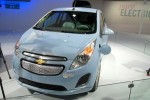
The 2012 Los Angeles Auto Show’s media preview days’ included cars and SUVS with record fuel economy. All of the mainstream vehicle introductions – whether the vehicle was fueled by gasoline, diesel, a gasoline-electric hybrid system (that may or may not plug in) or electricity – focused on the improved fuel economy of the vehicle being introduced.
There’s a reason – or two. First, as the automakers are demonstrating, vehicle fuel economy is increasing across the board. Second, customers are buying more fuel-efficient vehicles. Even with declining gas prices, the latest numbers from the University of Michigan UMTRI study show that. January through November of 2012 the sales-weighted fuel economy average of purchased vehicles has gone from 23.5 to 24.1 mpg. That’s only a 2.5% increase, but it follows on four years of measured increases. (The first month measured in Oct. 2007 showed a 20.1-mpg average.)
As if to underscore the point, the Environmental Protection Agency released the fuel economy ratings for 2013 cars and in the “best” category the worst combined fuel economy is 42 mpg for the Prius V mid-sized station wagon.
So back to LA. We saw the introduction of a couple models that may hit the top 20 best sellers for the year, including a plug-in version of the Honda Accord, a redesigned Honda Civic and the Ford Fusion being named Green Car of the Year. But the meat of the show hit models that, while not the best sellers in a lineup, were critical to the ongoing success of a brand. Those included the Toyota RAV4, Subaru Forester, Acura RLX, Ford Fiesta and Transit Connect Wagon, Kia Forte, Hyundai Santa Fe, Porsche Cayman, VW Beetle Convertible, Chevy Spark EV, three Fiat 500 variations and an AMG variant of the Mercedes-Benz GL, along with more exotic concept cars from several manufacturers. At least three companies – Audi, BMW and Mazda – talked more about diesel engines than new models, while Ford and Mitsubishi, among others, highlighted new technology available in their cars as much as new hardware.
If fuel economy was the frequent refrain, “class-leading” was the most popular adjective. That goal appears to be a moving target as each refreshed entry in a class seems to be poised to be the new “leader,” usually by an inconsequential one or two miles per gallon. I say inconsequential because as has been shown in the recent dust-up with Honda and Hyundai-Kia over their fuel economy claims, “your mileage may vary” has probably never carried more meaning than in current vehicles.
The plug-in vehicles that make up the EPA “best” received some new contenders, all with promises of sky-high fuel economy numbers, but the reality of the slow market acceptance of these new technologies also sank in. That’s part of a market shift that’s been going on for the past two decades. No longer are there several models selling a half million units per year. The market has become more fragmented and the consumers demands more diverse. On their side, automakers have generally learned the smart way to spin new models off of common platforms/architectures and make them appear and function in truly different ways. So the new RAV4 or Santa Fe may not sell 250,000 units, but it extends the reach and leverages the investment in the platform it’s built upon, which is shared with several car models.
Biggest Buzz of the LA Show
 1. BMW i3 coupe concept. While this is not a production vehicle and not the first time BMW has shown a version of the i3, it was one of most important cars at the show because of its groundbreaking technology. BMW’s extensive use of carbon fiber points the way toward extensive weight reduction with no loss of structural integrity and at a price point much-reduced from previous technologies. Carbon fiber is one of the critical technologies needed for EV success, but it also will play a role in keeping the internal combustion engine around as it lightens up vehicles so they can use smaller engines.
1. BMW i3 coupe concept. While this is not a production vehicle and not the first time BMW has shown a version of the i3, it was one of most important cars at the show because of its groundbreaking technology. BMW’s extensive use of carbon fiber points the way toward extensive weight reduction with no loss of structural integrity and at a price point much-reduced from previous technologies. Carbon fiber is one of the critical technologies needed for EV success, but it also will play a role in keeping the internal combustion engine around as it lightens up vehicles so they can use smaller engines.
2. Honda Civic. This car, while in the top five sellers in the country, was given a quick redo due to negative reviews when it was introduced last year. Honda upgraded the car’s interior and rushed the changes into production in record time. Even though the car’s sales are strong, Honda responded quickly to concerns about the model and with the changes should help it to continue as a strong contender in the compact class. As fuel economy continues to be an automaker and consumer focus, this size of vehicle becomes a key component to a brand’s success. In the same way the Cruze has led Chevrolet’s renaissance, a well-received Civic is a must-have for Honda to maintain its market position.
 3. Fiat 500e and Chevrolet Spark EV. I’ll throw these two together because they represent an important shift in the image of small electric vehicles. They still have relatively short range and have little distinguishing features compared to their internal engine-powered cousins, but these two models were presented as something EVs have not been up to this point–serious performance and cars with an image beyond merely green. The torque numbers these small cars throw up and the Fiat approach that “this is an Italian car first and an electric car second” is significant. The sales numbers may not be destined to be too high, but at their lower price points these two could help rehabilitate the EV image for a whole new class of consumers.
3. Fiat 500e and Chevrolet Spark EV. I’ll throw these two together because they represent an important shift in the image of small electric vehicles. They still have relatively short range and have little distinguishing features compared to their internal engine-powered cousins, but these two models were presented as something EVs have not been up to this point–serious performance and cars with an image beyond merely green. The torque numbers these small cars throw up and the Fiat approach that “this is an Italian car first and an electric car second” is significant. The sales numbers may not be destined to be too high, but at their lower price points these two could help rehabilitate the EV image for a whole new class of consumers.
 4. Audi and Mazda champion diesel. You could add BMW to the periphery of this new wave, along with Chevy and Mercedes. This is not simply dropping in diesel and noting how much more efficient it is than old port-injected gasoline engines. Both Audi and Mazda have state-of-the-art direct injection gasoline engines that offer some of the best fuel economy in their respective classes, but still feel there is a role for high-tech modern diesels. And, as Audi’s President Scot Keogh said at the show, this is the second generation of diesels with more expected to follow. The proliferation of diesels shows yet one more path that the auto industry is taking in its attempt to satisfy its customers desire for not just fuel economy, but functionality, hence the Audi diesel shows up in two SUVs as well as its full-size sedan.
4. Audi and Mazda champion diesel. You could add BMW to the periphery of this new wave, along with Chevy and Mercedes. This is not simply dropping in diesel and noting how much more efficient it is than old port-injected gasoline engines. Both Audi and Mazda have state-of-the-art direct injection gasoline engines that offer some of the best fuel economy in their respective classes, but still feel there is a role for high-tech modern diesels. And, as Audi’s President Scot Keogh said at the show, this is the second generation of diesels with more expected to follow. The proliferation of diesels shows yet one more path that the auto industry is taking in its attempt to satisfy its customers desire for not just fuel economy, but functionality, hence the Audi diesel shows up in two SUVs as well as its full-size sedan.
5. Ford Fusion as Green Car of the Year. For the first time, a model with one technology didn’t take home this trophy, which has been gaining prestige over the years. Previously, it’s been a battle between EVs, plug-ins, CNG, diesel, fuel cells and efficient gasoline cars. This year they gave the award to a Ford that would span several categories, coming in efficient gas, hybrid and plug-in hybrid models. It is a sign of things to come, where the consumer is going to be faced with much more complex choices in the showroom than at any time in the last century.
These five highlights of the LA Auto Show, the first major show of the season, may be sum of the direction of the automotive market. It ties things up nicely to say that new technology, rapid response to market changes, new images for alternative fuel/technology vehicles, ever-developing traditional technology and multi-faceted vehicles offering true consumer choice will be our future. And it is not happening way off in the future–these are all happening in the coming year. In that sense the LA Auto Show was a very timely window into what’s coming very soon.
